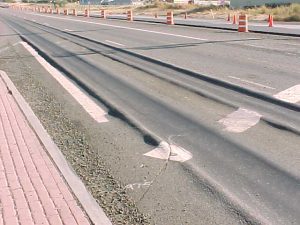Our roads are vital arteries, carrying us to work, school, and everywhere in between. But even the most well-constructed asphalt pavement can succumb to a common enemy: rutting.
What is Asphalt Rutting?
Imagine driving down a road with long, sunken grooves in the wheel paths. That’s asphalt rutting. It occurs when the asphalt surface undergoes permanent deformation under repeated traffic loads, creating depressions in the areas where vehicles travel most frequently.
What Causes Asphalt Rutting?
Several factors can contribute to asphalt rutting:
- Heavy traffic: Constant pressure from heavy vehicles, especially trucks, can accelerate rutting, particularly on roads not designed for such loads.
- Weak subgrade: The foundation layer beneath the asphalt (subgrade) plays a crucial role. If the subgrade is weak or unstable, it can’t adequately support the weight of traffic, leading to rutting.
- Improper drainage: Poor drainage allows water to accumulate under the pavement, weakening the subgrade and accelerating rutting.
- Exposure to extreme temperatures: High temperatures can soften the asphalt, making it more susceptible to deformation under traffic loads. Conversely, freeze-thaw cycles can cause the pavement to crack, creating entry points for water and further weakening the structure.
- Insufficient pavement thickness: If the asphalt pavement is not thick enough to handle the anticipated traffic volume and weight, it’s more prone to rutting.
The Impact of Asphalt Rutting:
While seemingly like a minor inconvenience, asphalt rutting can have significant consequences:
- Safety hazards: Ruts can cause vehicles to hydroplane, especially in wet conditions, increasing the risk of accidents.
- Reduced driving comfort: Uneven pavement surfaces create an unpleasant driving experience for motorists.
- Increased maintenance costs: Left unaddressed, rutting worsens over time, necessitating costly repairs or even complete pavement replacement.
Strategies to Prevent Asphalt Rutting: Keep Your Roads Smooth
Asphalt pavements are the backbone of our transportation network, but they’re not invincible. One common threat they face is rutting, those dreaded depressions in the wheel paths. Here’s how to prevent asphalt rutting and keep your roads smooth and safe:
1. Design for Longevity:
- Pavement thickness: Ensure the pavement is designed with adequate thickness to handle the anticipated traffic volume and weight. This requires considering factors like the number of lanes, expected vehicle types (cars vs. trucks), and projected traffic volume.
- Subgrade stability: Evaluate the subgrade (the layer beneath the asphalt) and address any weaknesses. This might involve soil stabilization techniques like adding crushed rock or geotextiles for reinforcement.
2. Prioritize Drainage:
- Efficient drainage systems: Implement well-designed drainage systems that effectively remove water from the pavement surface and the subgrade. This includes properly functioning gutters, channels, and culverts to prevent water from accumulating and weakening the pavement structure.
- Regular maintenance: Regularly clean and maintain drainage systems to ensure they function properly and prevent blockages that could lead to water pooling.
3. Choose the Right Materials:
- High-quality asphalt mix: Opt for asphalt mixes formulated with durable aggregates and binders that can withstand traffic loads and resist deformation. Consider polymer-modified asphalt for added strength and flexibility.
- Proper compaction: During construction, ensure proper compaction of the asphalt layers to achieve optimal density and prevent future rutting.
4. Manage Traffic Loads:
- Weight restrictions: Enforce weight restrictions on roads not designed for heavy vehicles. Excessive loads can significantly accelerate rutting, especially on weaker pavements.
- Traffic calming measures: Consider implementing traffic calming measures like speed bumps or roundabouts to reduce vehicle speeds and minimize the impact of traffic loads on the pavement.
5. Regular Maintenance:
- Routine inspections: Conduct regular inspections of your asphalt pavements to identify any early signs of distress, such as minor cracks or raveling.
- Prompt repairs: Address minor issues promptly to prevent them from progressing into severe rutting. This might involve crack sealing, patching, or resurfacing damaged areas.
By implementing these preventative strategies, you can significantly reduce the risk of asphalt rutting and extend the lifespan of your pavements. Remember, a proactive approach is crucial to ensure your roads remain safe, comfortable, and cost-effective for years to come.
TTAPCO Introduces the AkaBit Line:
TTAPCO is proud to introduce the AkaBit line, a range of premium polymer modified bitumen (PMB) products formulated to deliver exceptional performance and durability for your construction projects. The AkaBit line comprises distinct grades: EL64, EL70, and EL76, each meticulously designed to cater to a specific set of requirements and applications.

